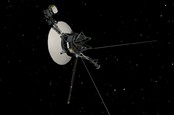This article is more than 1 year old
Voyager 1 data corrupted by onboard computer that 'stopped working years ago'
Deeply impressive that NASA engineers fixed telemetry transmit glitch on 1970s probe in the first place
NASA knows the how but not the why of a telemetry data routing snafu that caused "garbled" information about the 45-year-old Voyager 1 probe's position to be sent to mission controllers on the ground.
The space agency's engineers announced a fix of the issue last night, saying they'd discovered the data was being routed through the wrong place altogether – an onboard computer the team said was "known to have stopped working years ago," which then "corrupted the information."
Calling the fix from billions of miles away the "ultimate telesurgery," Voyager propulsion engineer Todd Barber said the team were "delighted" after being left "flummoxed" over the nonsensical attitude control telemetry. "We couldn't get any health and safety info about the pointing of the spacecraft or any of the thruster operation," he noted.
The ground crew needs data from the venerable 1970s probe's attitude articulation and control system (AACS) to control the spacecraft's orientation. One of the most crucial functions of AACS is to keep Voyager 1's high-gain antenna pointed precisely at Earth, or else it won't be sending any data home.
When the problem first cropped up in "March or April", the Pasadena techies were quick to point out that the craft, which entered interstellar space in 2012 and is currently the farthest human-made object from Earth, was operating normally.
- 43 years and 14 billion miles later, Voyager 1 still crunching data to reveal secrets of the interstellar medium
- Let's go space truckin': 1970s probe Voyager 1 is now 14 billion miles from home
- How's your night sky looking? The Reg chats to astroboffin Mark McCaughrean about Starlink and leaving a mark
- 'That's here. That's home. That's us': It's 30 years since Voyager 1 looked back and squinted at a 'Pale Blue Dot'
It was receiving commands from Earth and executing them, as well as gathering and returning science data, all without any compromise of the signal, suggesting those AACS values were actually in good shape. The team said at the time the data they were receiving didn't actually reflect "any possible state the AACS could be in," adding: "Voyager 1's signal hasn't weakened, either, which suggests the high-gain antenna remains in its prescribed orientation with Earth."
Suzanne Dodd, Voyager's project manager, said that as the team had suspicions about the underlying issue, they opted to try a low-risk solution: commanding the AACS to resume sending the data to the right computer – confirming their thesis as it apparently worked.
It's not yet known why the probe started sending telemetry to the wrong box, but NASA says it is likely it received a faulty command generated by another onboard computer. "If that's the case, it would indicate there is an issue somewhere else on the spacecraft," the JPL team added, saying it would keep looking for the underlying issue, but didn't think it a "threat" to Voyager 1's long-term health.
The fact that we still receive data 45 years later from the craft, currently 22.5 billion kilometers (14 billion miles or about 20 light-hours) away from Earth, is extraordinary, and some of the original team members were on hand to discuss it yesterday.
Propulsion engineer Barber went on to list current issues with the craft. "We lose 4 watts [of power] a year on the spacecraft; things are insanely cold; the propellant lines are about to freeze; we've had computer chip issues," he said, adding that it was "kind of like keeping an old car running – they are geriatric by NASA standards and it's been the hardest engineering I've done in my entire career but also the most fun."
The probe, launched in 1977 and sporting a 3.7-meter-wide (12ft) radio antenna dish, was originally designed to last the five years the agency believed it would take to conduct closeup studies of Jupiter and Saturn, Saturn's rings, and the larger moons of the two planets.
The Register found it interesting that the telemetry problem was disclosed in May, but when the Voyager engineers appeared live yesterday, it seems it may have started much earlier, in March or April, making us wonder about the vetting process for information even on veteran craft. Barber also noted that "we announced the fix today."
Speaking more broadly about Voyager's resilience, deputy project scientist Linda Spilker said during the live Q&A yesterday: "All of the computers are redundant on Voyager and we knew from an earlier flyby of Pioneer going by Jupiter that Jupiter's radiation environment was quite harsh. So we did a lot of things to radiation-harden the two Voyagers and that stood them in good stead not just for their Jupiter flybys but now in interstellar space, where those cosmic rays or high-energy radiation is greater – that extra little protection is at work still."
When was the last time you did some troubleshooting on 1970s tech? Let us know in the comments below. ®

